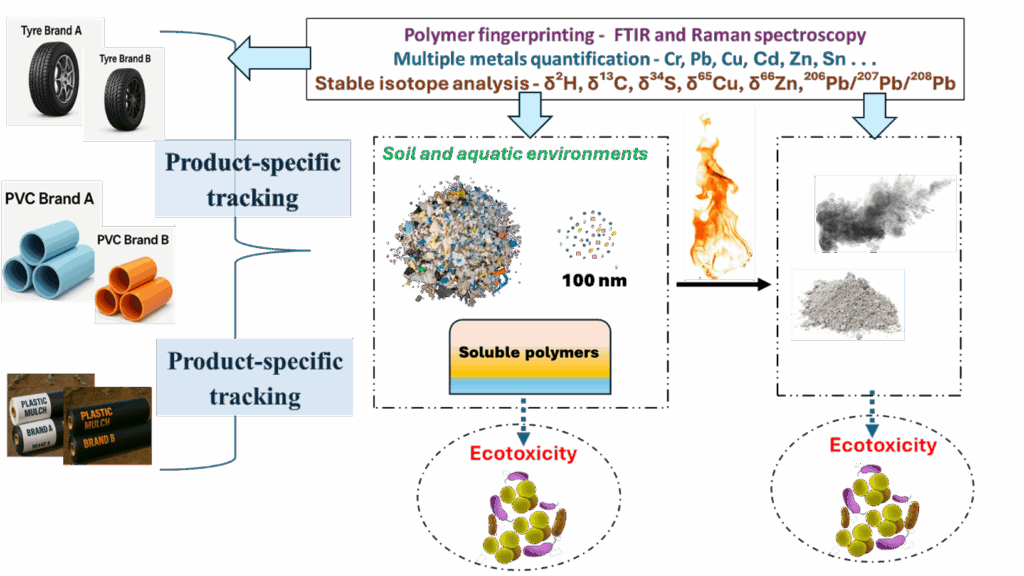Linking Origins to Hazards: A Forensic Approach to the Fates and Toxicodynamic of Microplastics, Nanoplastics, and Tyre Wear Particles
Project Summary
This PhD will deliver the first comprehensive polymer- and brand-specific hazard profiles for synthetic polymers. It will achieve this by forensically tracing the fate of specific products—and even formulation differences between manufacturers—from their origin, through environmental transformation and waste incineration, to their ultimate toxicological impact.
Project Overview
Synthetic polymers are now inseparable from modern society, with global production exceeding 400 million tonnes annually and expected to double by 2050. These materials are used across diverse applications, from durable PVC pipes and lightweight polyethylene packaging to agricultural mulch films and synthetic rubber tyres[1]. Tyre production alone exceeds 1.7 billion units per year, making tyre wear particles (TWP) one of the most prolific yet understudied forms of synthetic particulate pollution[2].
Once released, plastics fragment into microplastics (MPs) and nanoplastics (NPs), which are now detected in air, water, soils, sediments, and living organisms—including humans[3]. These particles are persistent, interact with co-contaminants such as heavy metals, and are associated with toxicological outcomes ranging from inflammation to endocrine disruption.
Despite mounting concern, current research often treats “microplastics” as a single, uniform pollutant. This generalisation overlooks key differences in polymer chemistry, brand-specific manufacturing, and environmental behaviour. The lack of source apportionment prevents accurate, product-specific risk assessments and obscures critical differences in degradation rates and hazard potential.
Waste management compounds this problem. Most plastic waste is either landfilled or incinerated, yet the polymer-specific consequences of incineration—distinct emission profiles, residue toxicities, and environmental persistence—remain poorly understood. The absence of this knowledge fosters generic waste handling policies, provides no meaningful feedback to manufacturers, and fails to identify or regulate the most hazardous materials.
This systemic oversight has created a critical barrier to evidence-based regulation and sustainable polymer design.
Project Aims
This PhD will address these gaps by developing a forensic origin-to-hazard framework that tracks the lifecycle of MPs, NPs, and TWP from product source to toxicological outcomes.
Focusing on high-volume synthetic products (packaging, textiles, agricultural films, and tyres), the project will:
- Develop a forensic framework to trace polymers from manufacture to environmental release and end-of-life.
- Characterise transformations, including fragmentation, chemical alteration, and interactions with co-pollutants, under both controlled and real-world conditions.
- Assess toxicological impacts through uptake, distribution, and effects within terrestrial systems.
Key Tasks
- Source multiple brands of widely used polymer products.
- Pulverise and fractionate them into MPs and NPs.
- Establish baseline fingerprints using IR, Raman, GC–MS, ICP–MS, and isotope ratio mass spectrometry, under both pristine and UV-aged conditions[3,4,5].
- Advance identification and characterisation within simplified soil matrices and under controlled incineration scenarios.
- Refine detection and quantification in more complex soil and waste matrices.
- Integrate these findings to forensically constrain behaviour and toxicity within the soil–rhizosphere system.
Methodology
The project will combine advanced analytical and experimental approaches, including:
- Vibrational micro-spectroscopy (Raman, FTIR)
- Synchrotron-based micro-spectroscopy
- Isotope ratio mass spectrometry
- Ecotoxicological assays in terrestrial systems
Training
The student will receive multidisciplinary training at the interface of environmental science, analytical chemistry, and toxicology. They will develop expertise in:
- Advanced microscopy and spectroscopy
- Experimental design and ecotoxicology
- Statistical analysis and data interpretation
- Science communication and policy engagement
This training will equip the student for careers in academia, industry, regulation, or environmental consultancy.
Expected Impact
This PhD will produce the first product-specific hazard profiles for MPs, NPs, and tyre wear particles. Outcomes will:
- Provide evidence-based recommendations for polymer-specific waste management
- Inform safer product design and material innovation
- Contribute to precision regulatory standards
By shifting plastics governance from broad generalisations to a source-aware, forensic framework, the project will deliver insights of direct relevance to environmental agencies, industry, and policymakers. The results will have far-reaching implications for environmental protection, public health, and the sustainable manufacture of polymers.
References
1.Geyer, et al. (2017). Production, use and fate of all plastics ever made. Sci.Adv.,3.
2.Zhang et al. (2023). Tyre wear particles: Formation, measurement, properties and influencing factors. Atmos.Environ.,297.
3.Adediran et al. (2024). Fate and behaviour of microplastics (>25 µm) in water distribution networks. Water Res.,255,121508.
4.Vasudeva et al. (2025). Advances in microplastic characterisation: Spectroscopy and heavy metal adsorption. TrAC Trends Anal.Chem.,183,118111.
5.Birch et al. (2021). Isotope ratio MS and spectroscopic techniques for microplastics characterisation. Talanta, 224,121743.

